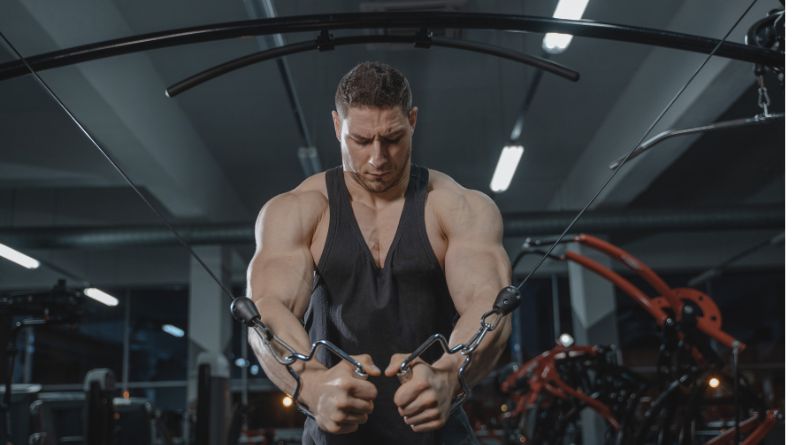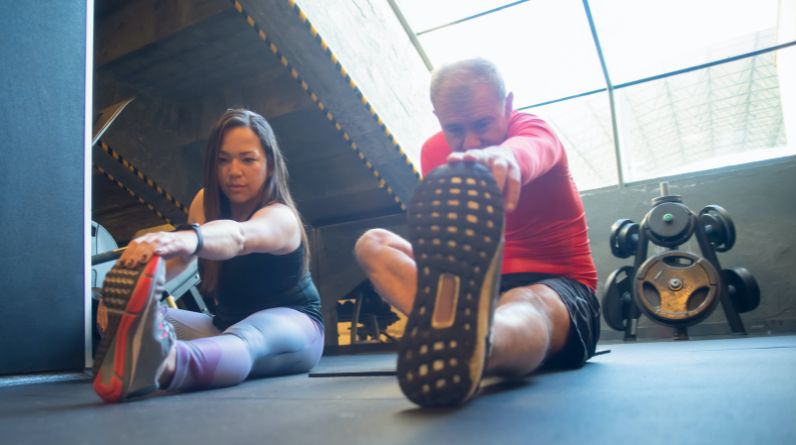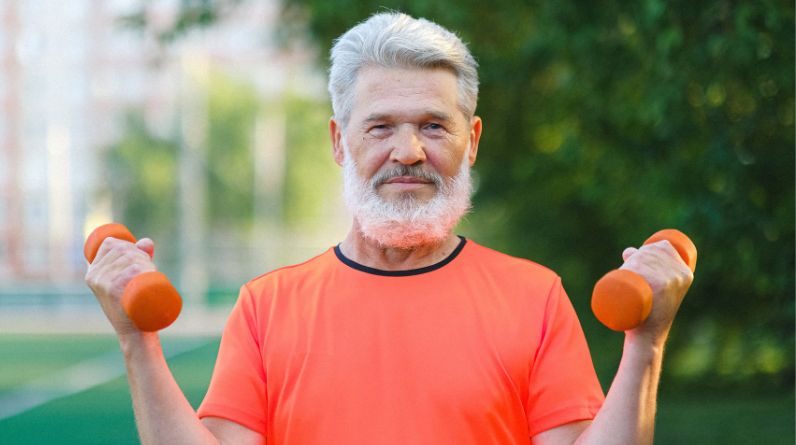
As we age, our bodies undergo various changes, and one common concern that many individuals have is the decline in muscle mass and strength. However, contrary to popular belief, it’s never too late to build lean muscle, even after reaching the age of 50. In fact, resistance training and a well-structured nutrition plan can help older adults not only maintain their muscle mass but also gain lean muscle and improve overall health and vitality.
In this article, we will explore the science behind building lean muscle after 50, the benefits of resistance training, the importance of proper nutrition, and practical tips to defy age and achieve a stronger and more muscular physique.
The Science of Muscle Loss and Aging
As we age, a natural process called sarcopenia occurs, leading to the gradual loss of muscle mass and strength. Sarcopenia is influenced by various factors, including hormonal changes, decreased physical activity, and reduced protein synthesis. By the age of 50, individuals may have experienced a noticeable decline in muscle mass, making it essential to address this issue with targeted interventions.
The Benefits of Building Lean Muscle After 50
Building lean muscle after 50 offers a plethora of benefits that extend beyond aesthetics. These include:
1. Improved Metabolism:
Lean muscle tissue has a higher metabolic rate than fat tissue, meaning that individuals with more muscle burn more calories even at rest. When we engage in resistance training and build lean muscle, our body’s metabolism increases, resulting in a higher basal metabolic rate (BMR). This means that our bodies require more energy (calories) to maintain muscle mass, which can be especially beneficial for those looking to manage their body weight or achieve weight loss goals.
Having a higher BMR not only allows us to burn more calories during rest but also makes it easier to maintain a healthy weight. As we age, our metabolism naturally slows down, which can make weight management more challenging. However, by building and maintaining lean muscle mass through regular resistance training, we can counteract this natural decline in metabolism and better regulate body composition.
2. Enhanced Bone Health:
Resistance training is not only beneficial for building muscle but also for stimulating bone density. As we age, bone health becomes a crucial concern, as our bones may become more susceptible to conditions such as osteoporosis and fractures. Osteoporosis is a condition characterized by low bone density and increased bone fragility, leading to a higher risk of fractures.
By engaging in weight-bearing resistance exercises, such as lifting weights or performing bodyweight exercises, we apply stress to our bones. This stress signals the body to reinforce the bones, making them stronger and denser. As a result, regular resistance training can help reduce the risk of osteoporosis and fractures, promoting better bone health as we age.
3. Increased Strength and Functionality:
Building lean muscle not only enhances our physical appearance but also improves functional strength and overall functionality. As we age, functional strength becomes essential for performing everyday activities with ease and reducing the risk of injuries. Tasks like carrying groceries, getting up from a chair, or climbing stairs require strength, and building lean muscle can significantly improve our ability to handle these daily activities.
Moreover, increased functional strength can enhance our independence and quality of life as we age. It allows us to maintain our mobility, perform activities without assistance, and enjoy a more active and fulfilling lifestyle.
4. Better Insulin Sensitivity:
Insulin sensitivity refers to how well our cells respond to insulin, a hormone that regulates blood sugar levels. Reduced insulin sensitivity can lead to insulin resistance, a condition in which our cells do not respond properly to insulin, resulting in elevated blood sugar levels. Over time, insulin resistance can progress to type 2 diabetes and metabolic syndrome.
Resistance training has been shown to improve insulin sensitivity, allowing our cells to better utilize glucose from the bloodstream. This can help prevent or manage type 2 diabetes and metabolic syndrome, two prevalent health concerns among older adults. By incorporating resistance training into our routine, we can support better glucose regulation and reduce the risk of related health issues.
5. Enhanced Hormonal Balance:
Regular exercise, particularly resistance training, can positively influence hormonal balance in the body. Hormones play a crucial role in various bodily functions, including metabolism, energy levels, mood, and overall well-being. Engaging in resistance training can trigger the release of hormones such as testosterone and growth hormone, which are essential for muscle growth and repair.
Moreover, resistance training has been associated with increased levels of endorphins, often referred to as “feel-good” hormones. These endorphins can elevate our mood, reduce stress, and enhance overall mental well-being. By promoting hormonal balance, resistance training can contribute to improved physical and mental health, supporting a better quality of life as we age.
Resistance Training for Lean Muscle Gain
Resistance training, also known as strength or weight training, plays a crucial role in building lean muscle after 50. It involves performing exercises against an external resistance, such as free weights, resistance bands, or bodyweight, to stimulate muscle growth and strength development. Here are some important points to consider when incorporating resistance training into your fitness routine:
1. Consult with a Healthcare Professional:
Before starting any exercise program, especially if you are new to resistance training or have pre-existing medical conditions or injuries, it is essential to consult with a healthcare provider or a qualified fitness professional. They can assess your individual health status and provide personalized guidance to ensure safe and effective workouts.
2. Start Slow and Progress Gradually:
If you are new to resistance training or have not exercised in a while, it’s important to start slow and progress gradually. Begin with lighter weights or resistance bands and focus on mastering proper form and technique. As you gain confidence and strength, you can gradually increase the resistance or weight to continue challenging your muscles.
3. Focus on Compound Movements:
Multi-joint exercises called compound motions work several muscle groups at once. These exercises are highly effective for building lean muscle mass as they recruit a larger number of muscle fibers. Examples of compound movements include squats, deadlifts, bench presses, overhead presses, and rows. Incorporating compound movements into your routine ensures that you work major muscle groups efficiently and effectively.
4. Include Resistance Bands and Bodyweight Exercises:
Resistance bands are versatile and can provide significant resistance for muscle building while being gentle on the joints. They are particularly useful for individuals who may have mobility or joint issues. Bodyweight exercises, such as push-ups, lunges, and planks, are excellent options for building strength without the need for additional equipment.
5. Incorporate Rest Days:
Rest and recovery are essential components of any successful resistance training program. After challenging workouts, muscles require time to recover and strengthen. Schedule regular rest days in your training program to allow your muscles adequate time to recover and avoid overtraining.
6. Stay Consistent:
Consistency is key to building lean muscle after 50. Aim to have at least three to four resistance training sessions per week to maintain progress and maximize muscle gain. Consistency in your workouts ensures that your muscles are consistently challenged, leading to continuous growth and strength development.
The Role of Nutrition in Building Lean Muscle After 50
In addition to incorporating resistance training into your fitness routine, proper nutrition plays a crucial role in building and maintaining lean muscle mass after 50. As our bodies age, there are certain dietary considerations that can optimize muscle growth and support overall health. Here are some essential nutritional factors to consider:
1. Adequate Protein Intake:
The building block of muscular tissue, protein is crucial for both muscle growth and repair. To support lean muscle development, aim to include a source of protein in every meal. High-quality protein sources include lean meats like chicken, turkey, and fish, as well as eggs, dairy products, legumes, tofu, tempeh, and plant-based protein options like quinoa and lentils. Consuming adequate protein throughout the day provides the amino acids needed for muscle protein synthesis, helping to repair and build new muscle tissue.
2. Balanced Macronutrients:
While protein is vital, it’s equally important to maintain a balanced intake of all three macronutrients: protein, carbohydrates, and fats. As opposed to lipids, which are important for hormone production and general health, carbohydrates give you energy for your workouts. Balancing all three macronutrients in your diet ensures that your body has the necessary nutrients to support muscle building and maintain energy levels.
3. Hydration:
For the best possible physical performance and recovery, it’s crucial to stay hydrated. During exercise, especially resistance training, our bodies lose water through sweat. Proper hydration helps maintain strength, endurance, and overall workout performance. Aim to drink plenty of water throughout the day, and consider sipping water during and after your workouts to replace lost fluids.
4. Nutrient Timing:
Timing your meals strategically around your workouts can have a positive impact on muscle protein synthesis and recovery. Consuming a meal or snack rich in protein within an hour after exercising provides your muscles with the necessary amino acids to kickstart the recovery process. This nutrient timing can optimize muscle repair and growth, especially when coupled with a well-designed resistance training program.
5. Consider Supplements:
While it’s best to obtain nutrients from whole foods, some individuals may benefit from supplements to support their muscle-building goals. Whey protein, for example, is a popular and convenient source of high-quality protein that can be easily incorporated into post-workout shakes. Creatine is another supplement that has been shown to enhance strength and muscle gains, particularly in older adults. Branched-chain amino acids (BCAAs) may also aid in reducing muscle soreness and supporting recovery. Before adding any supplements to your regimen, it’s essential to consult with a healthcare professional or a registered dietitian to ensure they align with your specific needs and goals.
Practical Tips for Building Lean Muscle After 50
Building lean muscle after 50 requires a thoughtful and well-rounded approach to fitness and nutrition. Here are some practical tips to help you on your journey to achieve your muscle-building goals:
1. Set Realistic Goals:
Define clear and achievable goals based on your individual fitness level and health status. Consider factors such as your current strength, flexibility, and any pre-existing medical conditions. Setting realistic goals will help you stay focused and motivated throughout your fitness journey.
2. Listen to Your Body:
As we age, our bodies may respond differently to exercise and nutrition. Pay attention to how your body feels during and after workouts. If you experience pain or discomfort, adjust your training or seek guidance from a fitness professional. Learning to listen to your body will help you avoid potential injuries and tailor your workout program to your specific needs.
3. Stay Patient and Persistent:
Building lean muscle takes time and dedication, especially as we age. Be patient with the process and celebrate every small victory. Stay persistent in your efforts, and remember that consistent and gradual progress is more sustainable in the long run.
4. Prioritize Recovery:
Recovery is as important as the workouts themselves. Allow your body enough time to rest and recover between resistance training sessions to prevent overtraining and reduce the risk of injury. Consider incorporating active recovery days, such as light walking or gentle stretching, to promote circulation and aid in muscle repair.
5. Work with a Personal Trainer:
If you’re new to resistance training or want personalized guidance, consider working with a certified personal trainer who has experience working with older adults. A trainer can design a safe and effective workout plan tailored to your goals and abilities, and provide valuable feedback on form and technique.
6. Include Flexibility Training:
Incorporating regular flexibility training, such as stretching or yoga sessions, can improve joint mobility and muscle flexibility. This can help reduce the risk of muscle tightness and injury, especially as we age and become more susceptible to stiffness.
7. Get Enough Sleep:
For healthy muscle recovery and overall wellbeing, get enough sleep. Aim for 7-9 hours of sleep per night to support your body’s recovery processes and promote optimal performance during workouts.
8. Stay Mindful of Your Nutrition:
Nutrition plays a significant role in building lean muscle. Be mindful of what you eat and aim to consume nutrient-dense foods that support your muscle-building goals. Prioritize a balanced diet with an adequate intake of protein, carbohydrates, healthy fats, and micronutrients.
9. Stay Consistent:
Consistency is key to building lean muscle after 50. Stick to your workout and nutrition plan even when progress seems slow. Consistent effort over time will yield significant results and lead to long-term success.
10. Enjoy the Journey:
Embrace the process of building lean muscle after 50 and celebrate your accomplishments along the way. Focus on the improvements in strength, energy, and overall well-being that come with regular exercise and a healthy lifestyle. Enjoy the journey and the sense of empowerment that comes with taking charge of your fitness and health.
Frequently Asked Questions
1. Can I build lean muscle after 50, even if I have never exercised before?
Yes, you absolutely can build lean muscle after 50, even if you have never exercised before. There is never a bad time to begin a fitness adventure. The human body has a remarkable ability to adapt to physical activity, regardless of age. Begin with beginner-friendly exercises and gradually progress as your strength and confidence improve. Focus on building a solid foundation with proper form and technique to reduce the risk of injury. Remember to start slowly and listen to your body as you embark on your muscle-building journey.
2. Is it safe to lift weights or do resistance training at my age?
Yes, resistance training can be safe and beneficial for older adults. Engaging in regular resistance training helps maintain muscle mass, bone density, and overall functional capacity as we age. To lower the chance of injury, start with lighter weights and concentrate on appropriate form and technique. It’s essential to consult with a healthcare professional, especially if you have any pre-existing medical conditions or concerns. A certified fitness trainer with experience working with older adults can help design a safe and effective resistance training program tailored to your individual needs.
3. How often should I work out to build lean muscle after 50?
Aim for at least three to four resistance training sessions per week to build lean muscle after 50. Give each muscle group adequate time to recover between workouts. For example, you can focus on different muscle groups on different days, such as upper body on one day and lower body on another. Remember that rest and recovery are essential for muscle growth, so avoid overtraining and allow your muscles time to repair and grow.
4. Do I need to lift heavy weights to build muscle after 50?
Lifting heavy weights is not always necessary to build muscle after 50. While lifting heavier weights can be effective for some individuals, focus on challenging your muscles with appropriate resistance for your fitness level. Performing exercises with proper form and a controlled tempo can also lead to significant muscle gains. Utilize a variety of resistance levels, including bodyweight exercises, resistance bands, and free weights, to continuously challenge your muscles.
5. Can I still build lean muscle if I have certain health conditions, such as arthritis or osteoporosis?
If you have certain health conditions such as arthritis or osteoporosis, it’s essential to consult with a healthcare professional before starting any exercise program. In many cases, exercise can be adapted to accommodate specific health conditions and needs. A tailored exercise plan, designed in collaboration with a healthcare provider and possibly a certified fitness trainer, can often be created to promote muscle building while considering individual limitations and ensuring safety.
6. How long does it take to see noticeable results in muscle gain after 50?
The rate of muscle gain can vary from person to person. Some individuals may notice improvements within a few weeks of starting a resistance training program, while others may take several months. The key is to stay consistent with your workouts and nutrition, as well as to set realistic expectations. Building lean muscle is a gradual process, and patience is essential. Celebrate every small improvement along the way, as each step brings you closer to your fitness goals.
7. Should I change my diet to support lean muscle gain after 50?
Yes, your diet plays a significant role in supporting lean muscle gain after 50. Consuming enough protein is essential for muscle growth and repair. Include foods high in protein in your diet, such as lean meats, poultry, fish, eggs, dairy, legumes, and plant-based sources of protein. Additionally, a balanced diet that provides sufficient calories, carbohydrates, healthy fats, and essential nutrients is essential for overall health and muscle-building efforts. Consider working with a registered dietitian to create a nutrition plan that aligns with your fitness goals and individual dietary needs.
8. Are bodyweight exercises effective for building lean muscle after 50?
Yes, bodyweight exercises can be highly effective for building lean muscle, especially for beginners or those who prefer low-impact workouts. Bodyweight exercises utilize your body’s weight as resistance and can be adapted to various fitness levels. Exercises such as push-ups, bodyweight squats, lunges, planks, and tricep dips can be excellent choices for building strength and muscle without the need for equipment. As you progress, you can add variations or increase the intensity to continue challenging your muscles.
9. Can I build muscle without using supplements?
Yes, building muscle can be achieved without using supplements. While some individuals may choose to include supplements like whey protein, creatine, or branched-chain amino acids (BCAAs) to support their muscle-building goals, it’s not a requirement for muscle growth. A well-balanced diet that meets your protein and calorie needs can provide the necessary nutrients for muscle repair and growth. Whole foods offer a variety of essential nutrients and are always the best foundation for a healthy diet. Remember, supplements should complement a healthy diet, not replace it, and it’s always a good idea to consult with a healthcare professional or registered dietitian before adding any supplements to your routine.
10. Is it necessary to change my exercise routine regularly to continue building muscle?
It can be beneficial to periodically modify your exercise routine to prevent plateaus and keep your workouts challenging and engaging. Our bodies are incredibly adaptive, so doing the same exercises with the same resistance and repetitions for an extended period may lead to diminishing returns. By incorporating new exercises, adjusting sets and reps, or trying different training techniques





